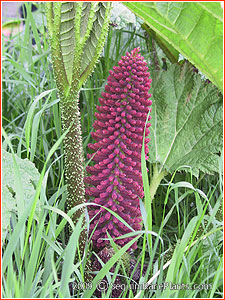 Gunnera tinctoria Gunnera tinctoria
- Click here to visit our Main Plant List page for current availability of this plant
- common names: gunnera, dinosaur food
- flowering season: summer; the large thick flower heads persist until cold weather
- height: 3 to 5 feet; much taller when grown in optimum conditions of ample water and a mild climate
- Light requirements: sun to partial shade
- Soil requirements: undemanding
- Water requirments: the more the better although at most, it only likes its ankles constantly soaking in water
- Growth habit: a large plant will often have a few smaller side plants
- How to propagate: by division or by seeds
- Leaf type: large roughly textured roundish leaves of green
- Ways to use it: when it is seen in a landscape it is usually planted alone so as to give it elbow room, although it will grow well next to other plants; a plant may well settle in at a height of 3 or 4 feet if it isn't fed and watered heavily -- and this size might be more appropriate for many places
- Special characteristics: when grown to near its full potential it creates conversation
- Other points of interests: when grown in a large tub it will grow quite large, for parts of the country that are too cold to leave it in the ground
Gunnera at nurseries that are labelled as G. manicata, are more likely to be this species. A lot of wishful thinking is taking place, wanting to grow the one that has the reputation for growing the largest. Gunnera tinctoria grows very large also. For a good illustration of the differences between tinctoria and manicata visit the website of the Royal New Zealand Institute of Horticulture at:
rnzih.org.nz, (click here) however their website is not always online. The surest distinction between the two species are the inflorescences, that is the "flowers" or seed cones illustrated by figures 3 and 4 on their website. For manicata they are more loosely packed and thinner while those of tinctoria are less open. Young plants are offered by us that after several years in your garden can easily grow very large leaves of five or even six feet across, on stems tall enough that an adult can stand beneath them. Prefers to have lots and lots of moisture. Grows well in full sun or partial shade. With interesting, if not highly colorful, cones of flowers at ground level. Established plants are hardy as far north as USDA Zone 7. Young plants need more protection than older, established plants. Do not plant them out in fall, but only in early summer to give them a good start before they face their first winter. If the top of a plant freezes and dies, it will often regrow from the buried part of the plant. The best winter covering is using it own big leaves that are cut off and layered together in the shape of a teepee over the crown of the plant. It is not the easiest plant to grow in the Southeast. There is an online garden forum where a gardener in upstate South Carolina (Zone 8a) mentions having a G. tinctoria that is six years old. Another Southerner on the forum recommends adding a large amount of peat to its soil and keeping the ground quite wet, for cool soil. |
|

 Gunnera tinctoria
Gunnera tinctoria